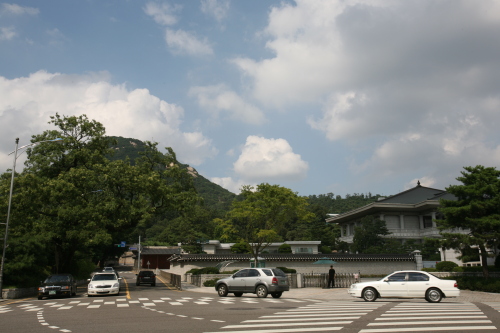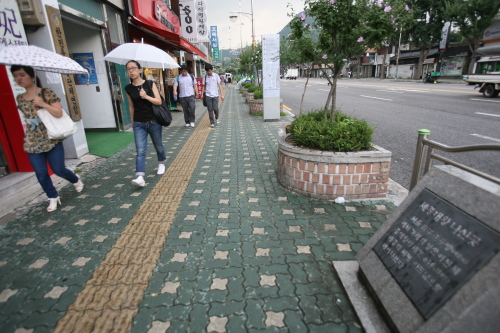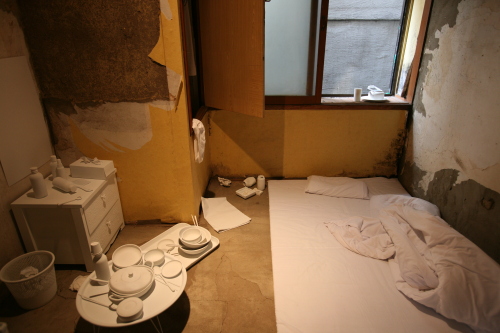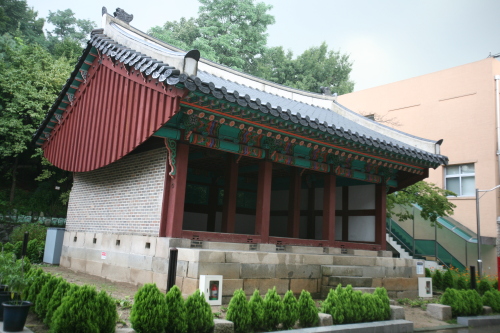
Mo Better Blues by Aaron Brown
Although there are plenty of people quick to comment on the negative influence that more puerile forms of Western music have had on K-pop, it’s possible to find positive influences in other musical genres. Jazz, the music that Wynton Marsalis described as “the music of now” has reached across cultural boundaries to enter the Korean musical consciousness with a vigor unmatched in previous decades.
If the true core of jazz music is best served through live performance, where are some of these Korean sound repositories, and what can they offer? Many readers will be familiar with the bigger names in Seoul’s jazz club scene like Once In A Blue Moon in Apgujeong,Cheonnyeondongando (천년동안도) in Hyewha, and All That Jazz in Itaewon, all of which are well-established venues and have been mentioned by numerous publications. We would like to offer our readers some other options, clubs that are not as well known and perhaps harder to find, but offer up a listening experience quite different from the better-known venues.
Finding a small, out-of the way place that can offer up true jazz delight has to be a highlight of any music fan’s life. Our first two clubs epitomize that sense of accomplishment perfectly. Located near Seoul National University, they are definitely off the usual jazz trail. Heading out of Nakseongdae St. (line 2, ex. 4), go straight till the first big intersection. Cross the street and turn left, continuing on until a three-way intersection. Jazz Alley is immediately on the right here. To get to Mo’ Better Blues, head down the small alley right across from Jazz Alley until you see the orange sign on the left above this basement bar.

Jazz Alley by Aaron Brown
The same man owns both clubs: Jang-deok Park.Mo’ Better Blues (just like the movie), which opened in 1999, is the older of the two. This is the quintessential basement jazz club: small, dark, smoky, and surprisingly intimate, although the decor is plain. The music is eclectic and accomplished. Some big names in Korean and international jazz have played here, including bassist Martin Zenker (Ugetsu), pianist John Nam, and drummer Chris Varga. Jazz Alley, Mr. Park’s other club, is much newer (it opened in November 2009) with a more spacious performance space and seating arrangement and less of a basement feel. The line-up of talent is similar to Mo’ Better Blues. Jang-eun Bae, one of Korea’s best jazz pianists, just finished a show there.
Hours: 6 pm – 2 am
Music: 9 – 11:30 pm Wed and Fri (Mo’ Better Blues),
Tue and Thu (Jazz Alley)
Drinks: lots of bottled beer, affordable wine
Location: Nakseongdae St. (line 2)
Web: cafe.naver.com/clubjazzalley
Phone: 02-882-5545, 011-9268-7704
As we move further along the less-travelled jazz club path, we head over to the Hongik University area to visit Moonglow and the old club Watercock, which has recently been renamed De Solar (though the sign is misspelled!) and has developed quite a weekend crowd.
Moonglow is the labor of love of pianist Shin-kwan Woong, a member of Korea’s older generation of jazz masters. He has been bringing a plethora of jazz styles to avid listeners for nearly three decades and has pretty much established Moonglow as the granddaddy of Hongdae jazz clubs. This large comfortable basement space has a great jazz atmosphere in which both performers and audience are transported back in time to a place where the outside world is but a memory. The headliners here include both foreign acts and local artists of the caliber of guitarist Hata Shuji, trumpeter Seon-bae Choe, and vocalist Nana. Shin-kwan Woong himself usually sits in and shows why he’s one of Korea’s jazz treasures. This is a great club to visit with a larger group of friends: the seating is ample, the sight lines excellent, the acoustics good, and the atmosphere lively. You may need to call for accurate directions.
Music: every night 9 – 11:30 pm
Drinks: decent wine list
Reservations: recommended on weekends
Location: Hapjeong St. (lines 6, 2)
Web: moonglow.co.kr
Phone: 02-324-5105
De Solar (formerly Watercock) is the other relative unknown in the Hongdae scene. It’s actually quite easy to find, even though it’s hidden behind the Smoothie King on the road that runs beside the park opposite the main gate of Hongik University. The club is owned by Cha Hyeon and has been going for seven years now. On the 1st floor, it’s kind of small, so it’s best to get there early to get a seat close to the stage, though the sightlines are all pretty good. All jazz styles are represented, but there is something of an emphasis on vocalists. Malo Cheong, one of Korea’s most original jazz vocalists, is a particular fave.
Music: every day 8:30 – 11 pm. Sun 7:30 - 10 pm
Location: Hongik University St. (line 2)
Web: blog.naver.com/desolar, Phone: 02-324-2422
It’s a bit of a jaunt from Hongdae to Apgujeong, but that’s where the intrepid jazz hound has to go to find Soul to God and JZ Cafe, the next hidden treasures in the Seoul jazz scene. Surprisingly, Soul to God remains off many people’s radar despite being just about a block and a half behind the more popular Once In A Blue Moon. This may be due to the fact it’s relatively new, having been open for less than a year, although owner Jeong-han Kim is working hard to change that. This is definitely a more upscale place: no small, cosily confined basement here. It offers up a quality jazz experience for those looking for a nice place to catch good music outside the main circuit. Pianist and jazz luminary J.C. Clark and his quartet A Taste of Jazz hold court here every Friday night and other top-quality performers grace the club on other days. Every month the club hosts a bigger name foreign band for a special event, and, from 6 pm – 2 am on the last Saturday of every month, there’s a “Live Jazz Event” with music, food, and drink all provided for a set price. Definitely a place to go for an out-of-the-ordinary jazz night out.
Music: Sun – Thu 7:30 – 11:30 pm, Fri & Sat 7:30 pm – 2 am
Cover: free
Drinks: extensive wine list, cocktails cost W20,000
Location: behind Apgujeong’s Ahnsei Hospital (Apgujeong St., line 3)
Web: soultogod.co.kr, Phone: 02-544-0095
A short distance away from Soul to God and just off the main drag near the Cinecity Theater,JZ Cafe© offers a nice menu of reasonably priced Italian dishes for any music explorers dealing with hunger pains. Live music can be enjoyed at JZ cafe© no matter which day you happen to go, though the really exciting acts are reserved for weekends. In addition to the standard mix of Korean groups, the occasional Japanese jazz band spices up the schedule.
Hours: 6 pm – 3 am, Cover: W5,000
Music: every day, see website for details
Drinks: beers start at W6,000, cocktails at W10,000
Location: between Apgujeong St. (line 3) and
Gangnam-gu Office (line 7)
Web: jzcafe.co.kr, Phone: 02-3444-2881
This is just a glimpse into some of the jazz venues that offer unique examples of artistic expression and show that external cultural influences need not be negative. Jazz can only help Korea and the outside world find more common ground through which to connect. If it is true that “Jazz is the folk music of the machine age,” then the venues that allow us to experience it in its most passionate form must be the factories that turn the raw material of jazz rhythms and harmonies into a rich, life-affirming experience through which all us “folk” can better understand each other.
Jazz Standards
If you haven’t been in Korea long, you probably haven’t even had a chance to visit the main jazz places we mentioned earlier. Here’s a list of the details for those of you who want to start out with the more famous half of Korea’s jazz clubs.
All That Jazz (Seoul) Itaewon’s jazz retreat has been around for years but it’s as unpretentious and intimate as they come. allthatjazz.kr, 02-795-5701
Once In A Blue Moon (Seoul) This swanky Cheongdam-dong joint is a jazz bar that puts a premium on class. onceinabluemoon.co.kr, 02-549-5490
Cheonnyeondongando (Seoul) Plenty of good food to go along with the jazz served up in this roomy 2nd floor Hyewha club.
chunnyun.com, 02-743-5555
Club Evans (Seoul) Come early if you want to get a seat at Hongdae’s most popular jazz spot. clubevans.com, 02-337-8361
Club Palm (Seoul) The other jazz club in Hongdae features a slightly less packed house with the same top talent. clubpalm.co.kr, 02-336-9016
Jazz bars outside of Seoul
The fact that Seoul is just so disproportionally preeminent in Korea means that most of Seoul’s classic jazz clubs are to be found there. Fortunately, however, readers in Daegu, Busan, and Jeju have venues of their own ready and waiting for them to drop by. (Those further afield itching for some live jazz may need to start looking into bus schedules.)
 Monk
Monk (Busan) is one of Korea’s old-guard jazz venues and a mainstay of the live music scene around Kyungsung University since 1992. Two other clubs closed recently, leaving it as the only full-time jazz club in Busan and a drawing card for all serious jazz lovers in the city. The club mainly showcases the talents of local bands, such as Jazz Point, Free Fall, and the Ahn Woo Song Project, but Monk also brings in foreign talent when it can, especially from Japan. One recent performer of note from the Canadian jazz scene was bebop legend P.J. Perry, a real coup indeed for a small jazz venue in Korea. The atmosphere, the music, and the slightly off-beat feel of Monk give the listener an experience that is more than the sum of its parts.
Hours: 6 pm – 2 am, Music: 9 – 11 pm, every night but Sun
Cover: W5,000, Location: Kyungsung Univ. (line 2, ex. 1)
Web: cafe.daum.net/clubmonk
Phone: 051-622-2212, 010-9543-5152
Club Sogong (Daegu)
Who: Korean jazz bands
Hours: 6:30 pm – 2:30 am, Music: Fri and Sat
Location: Daegu near Samdeok Fire Station
Web: clubsokong.com, Phone: 053-425-2535
Club That (Daegu)
Who: Korean bands, foreign bands in Korea, Japanese groups
Open: 7 pm – 4 am, Music: 9 pm once a week (Fri or Sat)
Cover: W5,000, Location: Daegu near Samdeok Fire Station
Web: clubthat.co.kr, Phone: 053-427-7171
Club Blue Hill (Jeju City, Jeju Island)
Who: mostly Jeju jazz and rock bands
Hours: 7 pm – 1 am (closed Mon)
Music: 9 and 10 pm on Thu, Fri, and Sat
Cover: W7,000 – W10,000, Location: Jeju City
Web: cafe.daum.net/clubbluehill, Phone: 064-702-2918


























